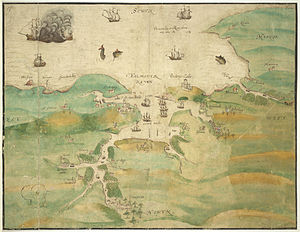
Back Invasión española de Inglaterra de 1597 Spanish Armada espagnole de 1597 French Invasione spagnola dell'Inghilterra del 1597 Italian 第三次西班牙无敌舰队远征 Chinese
| 3rd Spanish Armada | |||||||
|---|---|---|---|---|---|---|---|
| Part of the Anglo-Spanish War | |||||||
 Falmouth at the time of invasion | |||||||
| |||||||
| Belligerents | |||||||
|
|
| ||||||
| Commanders and leaders | |||||||
|
|
| ||||||
| Strength | |||||||
|
Fleet: 44 galleons 16 merchant galleons 52 hulks 24 small craft[4][5][6] Troops 9,634 soldiers 4,000 sailors[5] Total: 140 ships[7] 13,000[8]- 14,000 men[9] |
Fleet: 12 ships rising to 120 ships (23 October)[10] Troops: 500 (October) rising to 8,000 (November)[11] | ||||||
| Casualties and losses | |||||||
|
6 ships captured, 400 captured[12][10] Storms 22 ships sunk or destroyed 1,000 dead[9] Total: 28 ships,[13] 1,500 killed or captured[14][10] |
1 bark sunk[15] Low | ||||||
The 3rd Spanish Armada, also known as the Spanish Armada of 1597, was involved in a major naval event that took place between 18 October and 15 November 1597 as part of the Anglo–Spanish War.[16][17] The attack of the armada, which was the third attempt by Spain to invade or raid the British Isles during the war, was ordered by King Philip II of Spain in revenge for the English attack on Cadiz following the failure of the 2nd Spanish Armada the previous year due to a storm.[18] The Armada was executed by the Adelantado, Martín de Padilla, who was hoping to intercept and destroy the English fleet under Robert Devereux the 2nd Earl of Essex as it returned from the failed Azores expedition.[19][20] When this was achieved, the Armada would go on to capture either the important port of Falmouth or Milford Haven and use those places as a base for invasion.[21]
When the Spanish arrived in the English Channel, however, they were dispersed by a storm which scattered their fleet.[22] Even so, some ships did push on and even landed troops on the English and Welsh coasts.[23] The returning English fleet, which had been scattered by the same storm, were unaware that the Spanish had come to intercept them, and arrived safely in England with the loss of only one ship.[24][17] Padilla finally ordered a retreat back to Spain.[25][26] The returning English ships captured a number of Spanish ships, from which valuable information was obtained about the Armada.[26][27] Panic in England then ensued, partly because the English fleet had been out to sea with the English coast virtually undefended.[9] This caused the relationship between Queen Elizabeth I of England and the Earl of Essex[4] to deteriorate further and Charles Howard, the 1st Earl of Nottingham, took over from Essex as commander of the English fleet. Howard immediately sent the fleet out to hunt the Spanish, most of whom had arrived back at port.[28] Any remaining Spanish ships were rounded up and captured along with their soldiers and crew.[12][26][29] Philip took much of the blame for the failure by the Armada commanders, particularly Padilla.[25][30] The Armada was the last of its kind that the Spanish would execute under Philip II before his death.[3]
- ^ Wilson p. 162
- ^ Tenace, Edward (2003). "A Strategy of Reaction: The Armadas of 1596 and 1597 and the Spanish Struggle for European Hegemony". English Historical Review. Oxford Journals. 118 (478): 882. doi:10.1093/ehr/118.478.855.
- ^ a b Cruz p. 143
- ^ a b Hume p. 256
- ^ a b Wernham pp. 184–185
- ^ Tenace pp. 869–872
- ^ Ward, Adolphus William (1905). The Cambridge modern history Volume 3. p. 529. OCLC 502479358.
- ^ Bardon p. 158
- ^ a b c Bicheno p. 293
- ^ a b c Darby, Graham (1997). "Spanish Armada of 1597?". The Historian (53–60): 50–52.
- ^ Roberts, R. A. "Calendar of the Cecil Papers in Hatfield House, Volume 7: 1597". Sir George Carew to Robert Cecil. University of London & History of Parliament Trust.
- ^ a b Wernham pp. 188–189
- ^ Glete pp. 162–163
- ^ Hume pp. 262–263
- ^ Calendar of the Cecil Papers in Hatfield House, Volume 7: November 1597, 16–30 (Cecil Papers ed.). 1899. pp. 483–500.
- ^ Simpson p. 37
- ^ a b Graham pp. 212–213
- ^ Nelson p. 205
- ^ McCoog pp. 400–401
- ^ Kamen pp. 308–309
- ^ Polwhele, Richard (1806). The Civil and Military History of Cornwall; with Illustrations from Devonshire. The British Library: Cadell and Davies. p. 80.
- ^ Elton p. 383
- ^ Taunton p. 191
- ^ MacCaffrey p. 130
- ^ a b Innes p. 387
- ^ a b c Schomberg, Isaac (1802). Naval Chronology, Or an Historical Summary of Naval and Maritime Events from the Time of the Romans, to the Treaty of Peace 1802: With an Appendix, Volume 1. pp. 32–33.
- ^ Roberts, Richard Arthur; Salisbury, Edward; Giuseppi, Montague Spencer, eds. (1899). Calendar of the manuscripts of the Most Honourable the Marquess of Salisbury Volume VII. H.M.S.O. pp. 485–487.
- ^ Publications of the Navy Records Society, Volume 23. Navy Records Society. 1902. p. 73.
- ^ Thackeray/Findling p. 235
- ^ Hammer (2003) pp. 309–310
© MMXXIII Rich X Search. We shall prevail. All rights reserved. Rich X Search